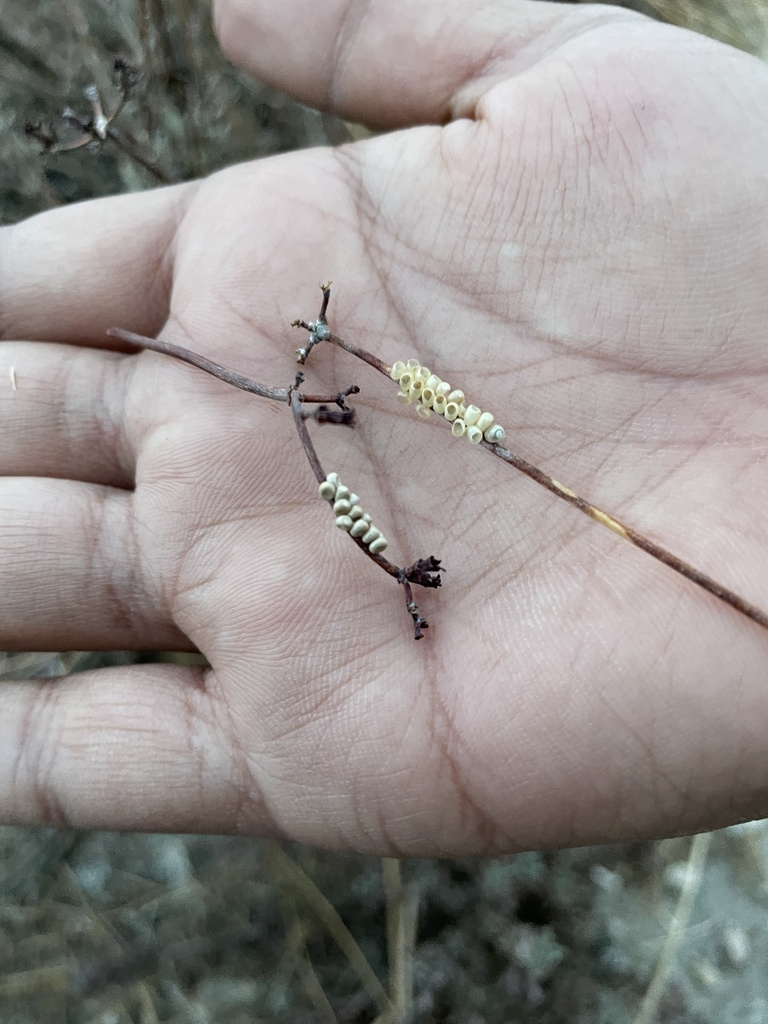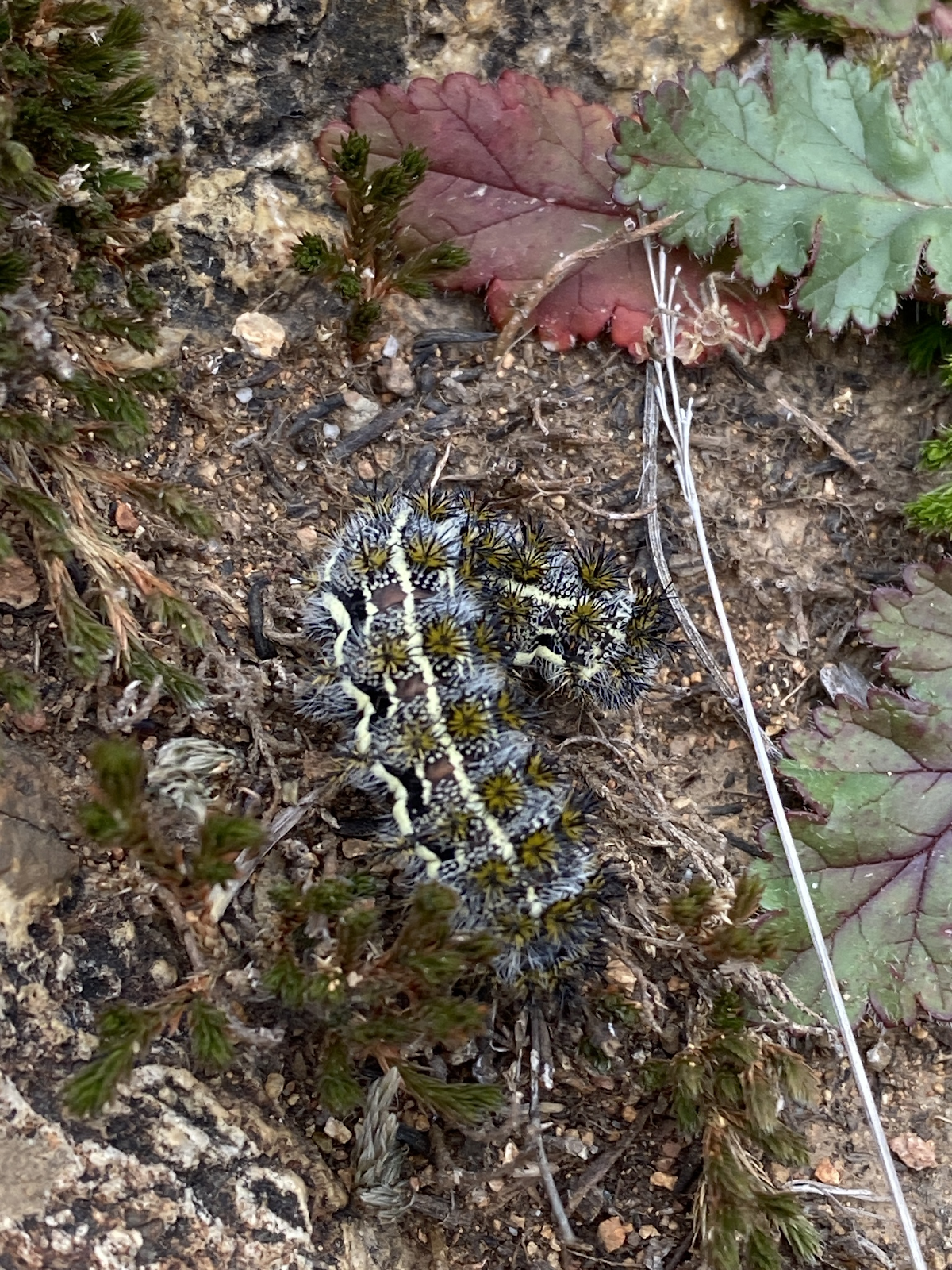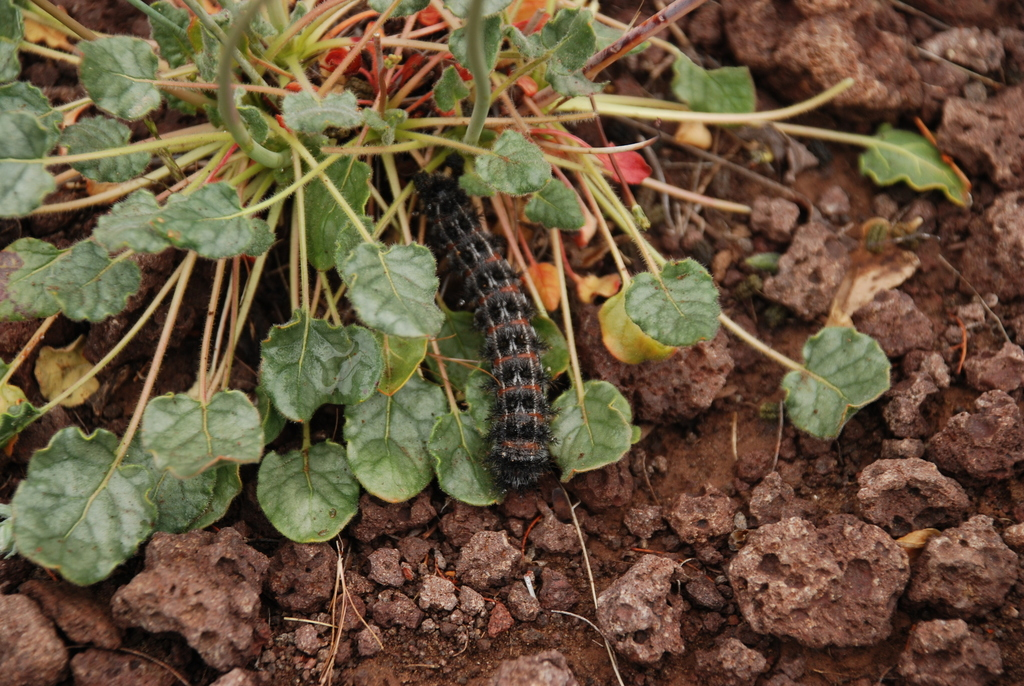Hemileuca electra, the Electra Sheep Moth, has much in common with H. eglanterina. It's a silk moth, though its relatively small size, folded wings, and shockingly colorful underwings can make it look like an oversized member of the Underwing family.
Photo donated to Butterflies & Moths of North America by Lynn Monroe. Note the translucent look of the fore wings, through which the hind wings show. Individual Hemileucas often have thinly scaled fore wings that look translucent.
It is yet another thing stingingworms grow up to be. Are the pretty day-flying moths worth putting up with stingingworms for? I'd say no, but out West some of the people who have to live with them feel differently. Certainly no nuisance insect justifies spraying poison into the air everyone else has to breathe--that only sets up a Vicious Poison Cycle that breeds bigger nuisances. However, my policy on stingingworms is that when we meet one we should find a big, heavy stick and do what comes naturally.
Electra usually lives and flies in Southern California, in between Las Vegas, Death Valley, the Pacific coast, and just south of the Mexican border. As a caterpillar it eats plants in the buckwheat family. As a moth it doesn't eat. Never really common in any part of the Southwestern States, the moths have been found as far north as Idaho. There are different subspecies, some of which were first classified as separate species, which complicates the question of exactly how far these animals' range extends. If they live in different places, on different foodplants, they will look different and may behave so differently as to seem like, for all practical purposes, a different species from their cousins. The genus Hemileuca defies humans' understanding of what a species is.
Before writing his big book on the silk moths of North America, Paul Tuskes studied the Hemileucas extensively, trying to understand the relationships among what looked like different species. Normally, if lifeforms hybridize easily and have viable offspring, they're considered varieties or races within a species; if they don't normally hybridize but can be crossbred, and produce offspring that are sterile or otherwise disadvantaged in terms of survival, they're different species in the same genus; and if they can't be crossbred without splicing genes, they're different genera. But when Hemileucas from the same brood are reared separately on different food, they may grow up to look as if they belonged to different species, and if the offspring are bred back together, their offspring may not be viable. Tuskes reported that Electras would crossbreed with Hemileuca eglanterina and H. diana, but not H. hera or H. nuttalli, and female Electras would accept H. burnsi as mates but female burnsi would not accept male Electras.
In a 1995 paper Tuskes observed that the subspecies rubra crossbreed readily with other Electras, but although many "hybridized" caterpillars hatched and seemed to mature normally, most died in the pupal stage. Of the "hybrid" moths, most females were sterile. This seemed to be equally true whether he was observing natural populations in a naturally occurring "hybrid zone" or rearing crossbreeds in the laboratory. The populations of H. electra electra and H. electra rubra continued to crossbreed freely despite a much lower rate of reproductive success. Tuskes could only theorize that the different forms Electras can take help the species to surve in a difficult environment.
Note the range of sizes and color patterns in Don Ehlen's collection of Electra carcasses. (And he didn't even include rubra.)
Hemileuca rubra used to be described as a different species. It looks like one. It is now considered a subspecies of Hemileuca electra.
Hemileuca clio was long regarded as a separate species, described as larger and darker than electra. Clio moths are more likely to fly in September, eggs are more grayish than greenish, and caterpillars have black rather than yellowish or greenish bristles. However, they crossbreed naturally, and a range of in-between patterns occurs.
Hemileuca mojavensis, or Hemileuca electra mojavensis, is normally smaller and paler in color than electra, except when environmental conditions produce the darker color pattern associated with clio in individuals of the smaller subspecies. Their eggs are more beige than grayish or greenish.
Older sources listed at least two other color patterns as distinct species or subspecies, but they seem to be merely color variations produced by eating different plants, not consistent indications of genetic differences. Electras also often have transparent or translucent forewings. This can be caused by loss of wing scales to wear and tear, or by a tendency for some of these moths' wing scales to curl up at the sides and not form a layer of solid color, or both. Like baldness in humans, this tendency is usually observed in males.
This Hemileuca electra rubra with translucent wings appeared on the back cover of Holarctic Lepidoptera/
The wingspan is 2.5 to 3 inches, though some mojavensis have wingspans under 2 inches; the body is less than 2 inches long, even counting the plumy antennae. Males and females look very much alike. One way to tell the sex of a newly eclosed Electra is that females are full of eggs while males have slim tapered body shapes; this difference becomes less pronounced as females unload their eggs. Hemileucas have no digestive organs and, for animals that live on stored fat, store remarkably little fat; the long flexible abdominal section exists only for reproductive purposes, and individual moths can survive, if not reproduce, if part of the abdomen is bitten off by a bird. (This seems to happen rather often. See below.)
Electras often conceal their bright colors as best they can when resting, and are likely to play dead, even dropping to the ground and curling up, if disturbed.
At the top of the Google search page for this insect, currently, is a photo of an Electra clinging gratefully, if moths can feel gratitude, to a man's thumb. The man was Jan Emming, who describes fishing the moth out of a bucket of water. Reflecting on how he'd only bothered to fish it out after seeing its pretty colors, he thought it had drowned. (It may have been playing dead.) As it dried out and warmed up, however, the cold-blooded animal revived. Emming put it near a potted plant to recuperate, and a spider promptly crawled out of the ground and ate it. Ah, Nature...The story is at https://janemming.com/2019/10/26/the-colorful-electra-buckmoth-hemileuca-electra-of-the-sonoran-desert/. The photo can be copied and pasted from Google, and bloggers have the right to fair use of Google images in unpaid blog posts, but this web site respects Emming's preference that his picture not be copied.
Californians may already be familiar with Calscape.org, which matches native moth and butterfly species with the native plants that attract them. It has several pages for plants Electras can eat. "Type in an address to see what eats this plant there, or what Hemileuca electra eats there," indeed. A business address that would work is the UCLA Store at 308 Westwood Plaza, Los Angeles, CA 90095. .
The normal life cycle lasts one year. Moths start to fly in September, are most active in October, and are sometimes seen in early November. The weather gives them few cues, though, and some moths fly at other times of year--probably losing their chance to reproduce. Nature does not make it easy for the big silk moths to reproduce. Electras are well adapted to their desert environment. They can hibernate in their pupal shells for more than one winter. Some reportedly survived as pupae for more than four years.
Upon emerging from the pupal skin the female climbs up a plant stem to expand her wings. How consciously she "calls" males with her scent is not clear, but as the little grublike animal stretches her stubby wings, the same pulse that fills the expanding wings with haemolymph (colorless moth blood) also pumps out pheromone scent from her back end. Click below to see a time-lapse video sequence of a female Electra maturing. When the tail end twitches, a scent humans don't smell is "calling" males for a mle around.
Males follow the scent and may surround the female by the time her wings have developed. How or whether she chooses one male is not clear, but she mates with one male, spends some time canoodling with him, then spends several minutes flying before she lays her eggs.
Probably most Hemileucas mate only once in their lives, if at all. The first mating is the one nature intended to produce the heir. After mating once the female stops releasing her pheromone "call," and most of her viable eggs are in the one brood she produces after mating. However, all the eggs are not released at once. The male, also, releases most of his viable sperm the first time, but has a few left. If individual moths get a second chance they'll mate two or, occasionally, even three times.
Circumstances that might allow Electras a second chance at moth "love" may include being close to a female who is still "calling." Males not selected by this female may approach another female who has already mated. However, although the Hemileucas often mate face to face and may spend a whole hour cuddling and admiring each other, male Electras seem even more clueless than males of most species. They are wired to react to the scent of a virgin female. A coldhearted researcher at Berkeley contrived a way to get a bit of rubber to pump out female Electra pheromones and placed it in a cage with two real female Electras who had already laid their first clumps of eggs. Male moths ignored the living females and courted the rubber decoy. The male Rubinoff photographed was apparently elected by other males to approach the decoy and fluttered over and around it. Apparently he felt that "her" lack of wings, legs, antennae, or responses to him were regrettable, but "she" smelled as if "she" were alive, and that was good enough for him. Natural selection rewards males' preference to be the father of the first brood because the first brood is the largest brood, containing the most viable eggs, the female will produce.
Hormone-ridden males of any species are not the clearest thinkers, but a lovesick male moth is not much brighter than a lovesick male mantis. Nevertheless, the moths spend time admiring each other.
In order to embrace like the couple shown, the moths use some of their legs to hold on to a branch strong enough to hold them. They are definitely drinking in each other's scent and caressing each other. Their wings hardly move for several minutes of cuddle time. Only some moths cuddle, even while mating; moths are highly motivated to protect their wings, and usually mate back-to-back to minimize the risk of touching each other. But the silk moths don't fly as much as most moths do; apparently they can afford the risk of wrapping their wings around each other, very carefully.
After 20 to 60 minutes of snogging, the female moth does most of the flying she intends to do in her lifetime, considering a few edible plants and placing her eggs around a stem.
The first batch of eggs is the biggest and contains the most viable eggs. Eggs are usually laid in October and hatch in December and January--the more temperate warm dry season, as distinct from the fiercely hot and arid season, in their primary habitat zone.
The colors of stingingworms can vary even within a litter. Paul Tuskes' monograph on recognizing the different species, or varieties, doesn't try to describe the possible colors of electra caterpillars but says that the tips of the branching bristles are white and the bristles form rosettes, with several tips of the same length to allow a more painful sting, on the upper middle section of the caterpillar only. His guide to identifying the stngingworms of California, Oregon, and Washington is free to read at
Photos show the variety of colors electra can have. Some even look as if they were trying to mimic tent caterpillars, which lack venom but are toxic to most animals that might eat them, and are avoided by most birds.
The severity of a stingingworm's sting has been found to depend on the number of sharp little tips that stick into the skin. The rosette-shaped, flat-topped bristles on electra's abdominal segments deliver more venom than the branch-shaped bristles on the thoracic and final segments.
In their second skins, these young caterpillars still have branch-shaped bristles on their backs like other Hemileucas, but the bristles on the backs are shorter. Bristles are shed with the skin when a caterpillar molts, which means fresh new bristles are already in place on the new skin and pop out as the caterpillar pulls out of the old skin.
This well camouflaged individual from Tijuana shows the green color some Electra caterpillars have. They share the green color and rosette-shaped bristles with stingingworms in the genus Automeris. Some, like this one, can be described as "plaid" or "checked" overall.
Found near Palm Springs (and about the same age and size as the other two), this one has white speckles, stripes, and bristle tips but still looks blacker than some younger Electras.
Or the white speckles can become predominant over the basic black or brown color of the skin, as on this individual found near Los Angeles.
This black-and-brown Arizonan is Hemileuca electra clio, sometimes listed as a separate species, Hemileuca clio.
This one, found near a beach west of Irvine, shows the red undertone many Hemileucas have. This was why Tuskes said that the shape of the bristles is more reliable than color is in identifying Hemileuca electra.
As caterpillars Electras find it effective to defend themselves against any danger, known or suspected, by curling up with their bristles outward. Jennifer Bundy reported that when she walked through the brush looking for specimens to study, the caterpillars would stop eating and drop off their host plant, actually making themselves more noticeable. The bristles absorb the shock when the curled-up caterpillars fall off plants or trees, at the expense of anyone below, and they repel most predators. As adult moths who have no bristles, Electras still try to defend themselves in the same way. Turning their backs out is not particularly discouraging to birds (roadrunners eat Electras) and may cost the moths a few abdominal segments. Male moths can survive and fly without their rear ends; they can't mate, but some of them might never have had a chance to mate anyway.
The defensive move that protected this moth, photographed by Docent for inaturalist.org, when it was a caterpillar now displays and increases its vulnerability as an adult moth.
Bristles do not discourage braconid wasps, which are small enough to crawl in between the bristles and lay eggs in the caterpillars' skin. Stingingworms parasitized by braconid wasps continue to eat and grow until the braconids pupate, forming little white cocoons in among the bristles. Since stingingworms don't groom themselves or one another, they can't do anything about the braconid infestation but wait for the tiny wasps to eclose. However, the parasitized caterpillars have been damaged and probably won't become adult moths.
The caterpillars eat wild buckwheat, jojoba, tamarisk when they can find it, and sometimes other things during Southern California's growing season (December to April, when temperatures are relatively mild and the agricultural parts of California get rain). Like other Hemileucas, they hatch looking black and gradually develop white and colored spots. Very young caterpillars clump together with their siblings to retain some warmth at night and some coolness in the hot afternoon. Though cold-blooded, they can shade and insulate one another. They stay together while eating their way through three skins. By the fourth instar (change of skin) they are too big and hungry to share one plant, so they go their separate ways. They need space to survive, but they tolerate each other's bristles and seem to get along well with one another.
When they pupate, usually in April to May, as desert dwellers they have access to dry sandy soil, into which they burrow down a little way. Michael Smith, considering electra and clio as different species (his clio caterpillars were much blacker, with a much thinner and straighter white stripe aong the sides), reported that both were hard to raise to maturity. They thrive in drier air, "cleaner" of fungi, than his Eastern base offered. The pupae, however, did very well in boxes of unused cat litter with a thin layer of shredded tissue on top. Smith didn't say whether he chose this medium based on the way large grayish caterpillars look from a distance. In any case they did as well in clean, very dry clay-based earth as in sandy soil.

















A reader explained that the photo of young caterpillars actually shows hatchlings with only two different looks, plus a few older siblings who have molted into their second caterpillar skins.
ReplyDeletePK